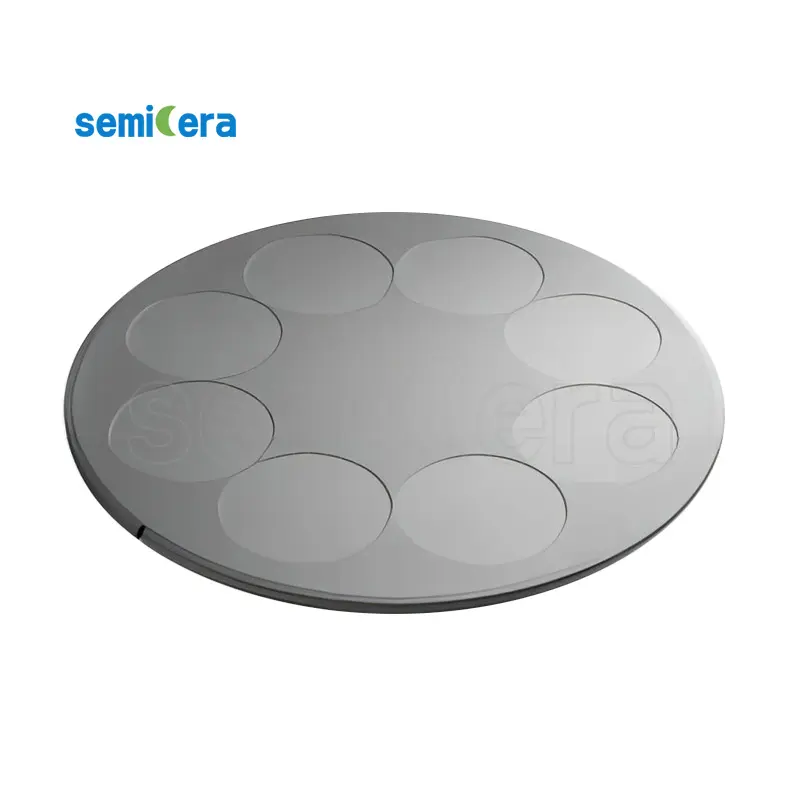
SiC coating has revolutionized industries by enhancing performance and durability. In aerospace, turbine blades coated with silicon carbide coating on graphite last 15-20% longer, reducing costs. Electric vehicles benefit from a 5-7% efficiency boost thanks to a graphite susceptor with silicon carbide, extending driving ranges. Renewable energy systems, like wind turbines, gain protection against wear with silicon carbide plating. The demand for better semiconductors also drives the adoption of SiC coating.
Key Takeaways
- SiC coating makes aerospace parts last longer. It increases turbine blade life by 15-20%, cutting down on repair costs.
- In electric cars, SiC coating boosts efficiency by up to 75%. This helps cars drive farther and improves battery life.
- SiC coating shields renewable energy systems, like solar panels and wind turbines, from damage. This keeps energy production steady and reliable.
Semiconductors
SiC coating in semiconductor manufacturing
SiC coating plays a vital role in semiconductor manufacturing. It protects components from extreme conditions, such as high temperatures and corrosive environments. This coating blocks silicon vapor at temperatures as high as 1500°C, which helps extend the lifespan of critical parts. Manufacturers also rely on SiC coating to meet strict performance standards in industries like aerospace and automotive without driving up costs. Its ability to resist wear and corrosion ensures that semiconductor devices last longer, reducing the need for frequent replacements.
Benefits for thermal management and high-purity applications
Thermal management is a major challenge in semiconductor production. SiC coating excels in this area by offering exceptional thermal stability and conductivity. It efficiently dissipates heat, preventing damage to sensitive components. Additionally, its high-purity properties make it ideal for applications where contamination must be avoided. This is especially important in processes like wafer fabrication, where even minor impurities can compromise performance. By using SiC coating, manufacturers can achieve better reliability and efficiency in their operations.
Innovations in SiC coating for next-gen electronics
Recent advancements in SiC coating technology are paving the way for next-generation electronics. Techniques like chemical vapor deposition (CVD) now produce SiC films with outstanding uniformity and minimal defects. These improvements enhance the performance and lifespan of semiconductors. Researchers have also integrated materials like graphene and carbon nanotubes into SiC coatings, boosting mechanical strength and thermal conductivity. For example, these innovations have reduced thermal resistance by up to 30%. SiC coating is also critical for 5G technology, as it provides the thermal stability and electrical insulation needed for RF devices.
Aerospace

High-temperature applications of SiC coating
In aerospace, high temperatures are a constant challenge. Jet engines, for example, operate in extreme conditions where components face temperatures exceeding 1,500°C. SiC coating is a game-changer here. It protects critical parts like turbine blades and combustion chambers from oxidation, thermal shock, and erosive wear. This ensures that engines maintain their performance even under intense heat.
- SiC-coated ceramic matrix composites (CMCs) are widely used in advanced engines, such as the LEAP series by CFM International.
- These coatings can endure over 20,000 flight hours, making them essential for long-term reliability.
By using SiC coating, aerospace manufacturers can create engines that are not only more durable but also more efficient.
Enhancing structural integrity and weight efficiency
Aerospace engineers constantly seek ways to make aircraft lighter and stronger. SiC coating helps achieve this balance. It enhances the structural integrity of components while reducing overall weight. This is especially important for parts exposed to high stress, like engine components and airframes.
| Improvement Type | Percentage Improvement |
|---|---|
| Lifespan Extension | 15-20% |
| Maintenance Cost Reduction | Not specified |
| Downtime Reduction | Not specified |
These improvements translate to lower maintenance costs and fewer delays, which benefit both manufacturers and airlines.
SiC coating in space exploration technologies
Space exploration pushes materials to their limits. SiC coating plays a vital role in protecting spacecraft from extreme conditions, such as intense heat during re-entry or the harsh environment of outer space. Its ability to resist wear and thermal shock ensures that critical components, like heat shields and propulsion systems, perform reliably. This makes SiC coating an indispensable technology for advancing space exploration.
Automotive
SiC coating for electric vehicle components
Electric vehicles (EVs) are transforming the automotive industry, and SiC coating is playing a key role in this shift. By improving the efficiency of critical components, this technology helps EVs achieve better performance and longer ranges. For instance:
- Tesla’s third-generation inverter uses SiC-coated semiconductors, reducing energy loss by up to 75% compared to traditional silicon-based solutions.
- This reduction in energy loss translates to increased battery efficiency, allowing EVs to travel farther on a single charge.
SiC coating also enhances the durability of components like inverters and chargers, ensuring they can withstand the high temperatures and stresses of daily use.
Enhancing performance in hybrid systems
Hybrid vehicles combine internal combustion engines with electric motors, requiring advanced materials to optimize performance. SiC coating offers several benefits for hybrid systems:
| Benefit | Description |
|---|---|
| Enhanced Performance | SiC coatings improve the performance and durability of automotive components, especially in hybrid vehicles. |
| Improved Thermal Management | The coatings enhance thermal management, which is crucial for the efficiency of power electronics. |
| Market Growth | The shift towards electric and hybrid vehicles is increasing the demand for SiC coatings. |
By improving thermal management, SiC coating ensures that hybrid systems operate efficiently, even under demanding conditions. This makes it a valuable technology for the growing hybrid vehicle market.
Advancements in SiC coating for engine durability
SiC coating is not just for EVs and hybrids—it also benefits traditional engines. By applying this coating to engine components, manufacturers can significantly enhance durability and reduce wear. SiC coating protects parts like pistons and cylinders from high temperatures and friction, extending their lifespan. This means fewer repairs and lower maintenance costs for vehicle owners.
In addition, advancements in SiC coating technology are making it more accessible for automotive applications. Techniques like chemical vapor deposition (CVD) allow for precise and uniform coatings, ensuring consistent performance across all components. As a result, SiC coating is becoming a go-to solution for improving engine reliability and efficiency.
Renewable Energy
SiC coating in solar panel efficiency
Solar panels need to perform efficiently under tough conditions, like extreme heat and constant exposure to sunlight. SiC coating helps improve their performance by enhancing thermal conductivity and protecting against wear. This coating ensures that solar cells can handle high temperatures without losing efficiency. It also reduces the risk of damage from environmental factors, such as dust and moisture. By using SiC coating, manufacturers can create solar panels that last longer and generate more energy over their lifetime. This makes solar power a more reliable and cost-effective option for renewable energy.
Benefits for wind turbine longevity
Wind turbines face harsh environments, especially in offshore locations where salt-laden air and UV radiation are constant challenges. SiC coating provides a durable protective layer that shields turbine components from these damaging elements. This coating enhances the long-term reliability of wind turbines, ensuring they operate efficiently for years. Studies show that protective coatings like SiC are critical for extending the lifespan of turbines, reducing maintenance needs, and improving overall performance. With SiC coating, wind energy systems can deliver consistent power while minimizing downtime and repair costs.
Role in improving energy storage systems
Energy storage systems, like batteries, are essential for renewable energy solutions. SiC coating plays a key role in improving their efficiency and durability. For instance, it enhances the thermal management of battery cells, preventing overheating and extending their lifespan. This is especially important for large-scale storage systems used in solar and wind farms. SiC coating also improves the chemical stability of battery components, reducing the risk of degradation over time. By incorporating this advanced coating, energy storage systems can store and deliver power more reliably, supporting the growth of renewable energy.
SiC coating has become a cornerstone of industrial innovation. Its unmatched durability and thermal stability enhance performance across sectors like aerospace, semiconductors, and renewable energy. For instance, turbine engines with SiC-coated blades last 15-20% longer, reducing costs. As research progresses, SiC coating will unlock new possibilities, driving efficiency and sustainability worldwide.
FAQ
What makes SiC coating unique compared to other coatings?
SiC coating stands out for its exceptional durability, thermal stability, and chemical resistance. It performs well in extreme conditions, making it ideal for high-performance industries.
Can SiC coating improve energy efficiency?
Absolutely! SiC coating enhances energy efficiency in applications like electric vehicles, solar panels, and wind turbines by reducing energy loss and improving thermal management.
💡 Tipp: SiC coating is a game-changer for industries aiming to boost performance and sustainability.
Is SiC coating environmentally friendly?
Yes, SiC coating supports sustainability by extending the lifespan of components, reducing waste, and improving energy efficiency in renewable energy systems and electric vehicles.


